
The da Vinci Xi Robot-Assisted Surgery

The da Vinci Xi Robot-Assisted Surgery – An Intelligent Surgical Solution for Advanced Minimally Invasive Surgery to Enhance Precision Even in Hard-To-Reach Areas
Unlike conventional surgery, minimally invasive surgery only requires small incisions with superior advantages of less pain, reduced postoperative complications and faster recovery, compared to one large incision with more pain and typically delayed recovery. The da Vinci system is an advanced technology designed to enable surgeons to perform robotic-assisted, minimally invasive surgery, particularly in anatomically challenging areas. With the better dexterity, surgeons are able to efficiently perform complex surgery with a high degree of safety while minimizing operative complications and promoting a fast recovery.
Why The da Vinci Xi Robot-Assisted Surgery?

Who are good candidates for the da Vinci Xi?
Who are good candidates for the da Vinci Xi?
Robotic-Assisted Surgery using the da Vinci Xi can be applied to a wide variety of surgery, especially complicated cases or difficult-to-reach areas. These often include:
- Abdominal diseases and Hepato-pancreato-biliary diseases, e.g. hernias, gallstones, liver cancer, pancreatic cancer and gallbladder cancer.
- Gastrointestinal diseases, e.g. esophageal cancer and colorectal cancer.
- Thoracic diseases, e.g. lung cancer, chest wall cancer and thymus gland disease.
- Urological diseases, e.g. prostate cancer, bladder cancer and kidney cancer.
- Gynecological diseases, e.g. uterine fibroid or uterine cancer, ovarian mass and pelvic organ prolapse.
- Otolaryngology-Head and Neck diseases, e.g. Benign tumors in the throat, Neck masses, Tonsil cancer, Base of the tongue cancer, Laryngeal cancer and Nasopharyngeal cancer.
Robotic-Assisted Surgery using the da Vinci Xi system is currently the most advanced platform designed for a wide range of minimally invasive surgeries. Its innovative technology makes this robotic system versatile and suitable for different fields of surgery. Robotic arms with 3D camera and magnification allow enhanced visualization with better access to hard-to-reach locations, resulting in an improved surgical precision with less postoperative complication and faster recovery. In spite of its advantages, Robotic-Assisted Surgery might not be a treatment of choice for some patients. Consideration whether it is preferred treatment option should be supervised and made by the surgeons. At Bangkok Hospital, our surgeons are highly specialized and well-trained in robotic-assisted surgery, adhering to international standards. Our ultimate goal is to achieve the best possible surgical outcomes and patient’s safety, ensuring that all patients are in good hands.
What are advantages of the da Vinci Xi?
What are advantages of the da Vinci Xi?
The fourth generation of the da Vinci system, the da Vinci Xi yields benefits, including:
- Better access: Robotic arms are capable of free movements of nearly 360° on seven axes, thereby improving access to anatomically challenging or hard-to-reach areas
- More precise surgery: Surgery can be carried out efficiently since the robotic arm’s movements are highly precise with greater range of motion. The arms rotate instruments interchangeably in tight spaces in ways that are not otherwise possible.
- Improved visualization: A sophisticated camera provides magnified, high-definition views of the surgical area with a better visualization of vessels, nerves and muscles nearby, resulting in less complications caused by damages to the surrounding areas.
- Built-in tremor-filtration: Built-in tremor-filtration eliminates the surgeon’s hand tremors to prevent involuntary movements, allowing more surgical accuracy.
- Multi-quadrant surgery: It allows a single operation on several connected organs located in different abdominal quadrants without moving the position of the patient.
- Faster recovery: Due to small incisions, patients often experience less pain, shorter hospital with a quick return to daily life.
How do The da Vinci Xi work?
How do The da Vinci Xi work?
The da Vinci Xi is an advanced robotic surgical system using specialized technology that enhances the capabilities of surgeon’s hands. As an expandable, computer-assisted surgical system, four surgical arms consisting of tiny instruments with wrists at the tip allow surgeons to accurately perform procedures in difficult-to-access or complex areas with precise movements, better dexterity and enhanced magnification. A special high-definition camera attached provides magnified 3D views of the operating area, leading to high degree of surgical accuracy and patient’s safety. For every movement, the surgeon makes at the console standing next to the surgical arms whilst the da Vinci robot replicates every move inside patient’s body on a smaller scale. The surgeon has complete control during the entire procedure according to surgery type.
Considered a world-class supercomputing system, Robotic-Assisted Surgery is intended to provide real-time endoscopic visible and near-infrared fluorescence imaging, enabling precise and accurate surgery. Moreover, built-in tremor-filtration technology similar to that installed in a camera substantially helps the surgeon to move each instrument with smooth precision, bringing about reduced operative complications due to less injuries to surrounding tissues, vessels and nerves. Robotic-Assisted Surgery has been currently applied to several types of surgical procedures. It is frequently used in general surgery, urologic surgery, thoracic surgery, gynecological surgery and colorectal surgery as well as head and neck surgery. Since minimally invasive surgeries have turned into common procedures, Robotic-Assisted Surgery has become widely accepted across the world, granted by the US FDA approval.
Due to the fact that robotic surgical technology is not able to move and perform surgery on its own, surgeons are in control at all times. During surgery, the surgeon makes one or more small incisions. Ports or thin tubes are placed through these tiny incisions. The robot will be attached to these ports and instruments are then placed through them. A long thin camera or endoscope providing high-definition images in 3D during the surgery is then inserted through one of the ports which allows the surgeon to perform the operation. To operate, the surgeon controls the robotic arms using his/her hands and fingers while sitting at a console a few feet away from the patient. Safety mechanisms are in place ensuring the robot does not move without having the surgeon controlling it. An assistant surgeon stays next to the patient in order to help the surgeon by changing the instruments when needed.
What does the da Vinci Xi system consist of?
The da Vinci Xi system uses specialized technology to assist surgeons in carrying out complex procedures. The da Vinci Xi system is comprised of three main components: a surgeon console, a patient-side cart and a visual cart.
- Surgeon console: At the console as the workstation, the surgeon controls 3D endoscope and the EndoWrist instruments with fully wristed dexterity using master controls and pedals. The alignment of the surgeon’s eyes, fingers, hands and instruments is perfectly replicated in the viewer display while the da Vinci robot imitates the movements inside the patient’s body on a smaller scale. Detailed visualization at the console ensures that the maneuvers made by the surgeon are safe and precise.
- Patient-side cart: The cart consists of four arms, making up the surgical component of the robotic system. The first robotic arm holds the endoscope and displays the 3D images on the viewer display. Whereas another three robotic arms attached with surgical instruments are latched deriving from a remote center, allowing the robotic arms to move freely, thereby reducing the force exerted on the patient’s body to a minimum while providing a better access to hard-to-reach locations.
- Visual cart: The visual cart is the image-processing unit composed of advanced vision and energy technologies to provide communications across da Vinci system components.
The da Vinci Xi Robotic-Assisted Surgeons Team
At Bangkok Hospital, our surgeons are highly specialized and well-trained in robotic-assisted surgery, adhering to international standards. Our ultimate goal is to achieve the best possible surgical outcomes and patient’s safety, ensuring that all patients are in good hands.


Dr. Padungkiat Tangpiroontham
Thoracic Surgeon

Asst. Prof. Dr. Tanet Thaidumrong
Laparoscopic Urological Surgeon

Dr. Sermsin Sindhubodee
Laparoscopic Urological Surgeon

Asst. Prof. Dr. Supreecha Asavakarn
Hepato-Pancreato-Biliary Surgeon

Dr. Ussapol Tantarawongsa
Laparoscopic Urological Surgeon

Dr. Chanin Pundee
Laparoscopic Surgical and Colorectal Surgeon

Assoc. Prof. Dr. Thun Ingkakul
Hepato-Pancreato-Biliary Surgeon

Dr. Yingchi Wang
Gynecological Surgeon

Dr. Pisit Tempatarachoke
Laparoscopic Urological Surgeon
|
Robot-Assisted Surgery Packages |
Length Of Stay (Night) |
Price |
|
Robot-Assisted Cholecystectomy Level 2* |
2 |
319,000 |
|
Robot-Assisted Cholecystectomy Level 3* |
4 |
434,000 |
|
Robot-Assisted Groin Hernia Repair with Mesh graft (one side) |
2 |
307,500 |
|
Robot-Assisted Groin Hernia Repair with Mesh graft (two sides) |
2 |
480,000 |
|
Robot-Assisted Umbilical Hernia Repair with Mesh graft |
2 |
363,800 |
|
Robot-Assisted Sleeve Gastrectomy |
3 |
690,000 |
|
Advanced Robot-Assisted Thoracic Surgery (RATS) Lobectomy |
3 |
783,000 |
|
Robot-Assisted Thoracic Surgery Thymectomy |
2 |
700,000 |
|
Robot- Assisted Radical Prostatectomy with Lymphadenectomy : A |
4 |
978,000 |
|
Robot – Assisted Radical Prostatectomy with Lymphadenectomy : B |
7 |
990,000 |
|
Robot – Assisted Partial Nephrectomy : A |
4 |
978,000 |
|
Robot – Assisted Partial Nephrectomy : B |
7 |
990,000 |
|
Robot-Assisted Wedge Hepatectomy |
4 |
982,000 |
|
Robot-Assisted Hepatectomy |
5 |
1,108,000 |
|
Robot-Assisted Distal Pancreatectomy |
7 |
982,000 |
Terms and conditions
- Surgical option depends patient’s condition and surgeon’s consideration. These prices include the operating room, recovery room, medical supply, medicines for specified operation, surgeon team and anesthesiologist team only.
- These prices include standard inpatient room, nursing service, food package, medical equipment, medical supply and medicines for specified operation.
- These packages apply to Fly-in patients only.
- These packages are valid from 1 January – 31 December 2025.
Remarks
- The patient is required to be evaluated for medical clearance by an internal medicine physician prior to surgery. This is an additional cost.
- These packages exclude the consultation fees if the specialist is needed.
- These prices exclude the treatment cost for patient’s underlying or related conditions. In case any surgical complication develops, additional charge will apply. These prices exclude special medical supply, implants, laboratory and other investigation.
- In case the patient stays in an Intensive Care Unit (ICU) longer than what the package specifies due to his/her condition, all the cost will be charged directly to the patient and cannot be deducted from the package price.
- These prices exclude pathology, laboratory test, special instrument and pathologist charges.
- These prices exclude home medication and patient’s comorbidity.
** Bangkok Hospital reserves the right to change the price at any time without prior notice.**
For more information, please contact
Surgery Center, Bangkok Hospital
Tel. (+66) 2310 3002, LINE OA: @BHQSurgery
Urology Center, Bangkok Hospital
Tel. (+66) 2310 3009
Woman’s Health Center, Bangkok Hospital
Tel. (+66) 2310 3005, (+66) 2755 1005
Cardiothoracic Surgery Center, Bangkok Heart Hospital
Tel. (+66) 2310 3033, (+66) 2755 1033, Hotline: 080-1919019, LINE OA: https://lin.ee/1eSlfssXe
Specific Cancer Center, Cancer Hospital Wattanosoth
Tel. (+66) 2755 1188
Related Articles

The da Vinci Xi - Robot-assisted system for minimally invasive thoracic surgery
Thoracic conditions, e.g. lung, respiratory diseases, and esophageal diseases have affected a large number of people worldwide.

The da Vinci Xi - Robot-Assisted System For Minimally Invasive Urological Surgery
The urinary system is crucial to the body as it filters the blood, removing waste and excess water. Urologic diseases affect parts of the urinary system which includes the kidneys, renal pelvis, ureters, bladder, prostate gland and urethra.

The da Vinci Xi - Robot-Assisted System For Minimally Invasive Abdominal Surgery
Medical advancements in surgery have continued to expedite the pace of changes, allowing better treatment outcomes for patients who require abdominal surgery, ranging from gallstones to pancreatobiliary diseases

The da Vinci Xi - Robot-Assisted System For Minimally Invasive Gynecologic Surgery
Gynecologic diseases are the conditions that affect the female reproductive system, such as the uterus, cervix, ovary, fallopian tube and vagina

The da Vinci Xi - Robot-Assisted System For Minimally Invasive Otolaryngology-Head And Neck Surgery
Head and neck surgery is used to treat a wide range of Ear, Nose and Throat (ENT) conditions affecting the neck, mouth, throat, salivary glands and sinuses, as well as both non-cancerous

The da Vinci Xi - Robot-assisted system for minimally invasive gastrointestinal surgery
Gastrointestinal diseases can strike anyone at any age. A wide variety of conditions can affect the gastrointestinal tract, starting from esophagus, stomach, liver, gallbladder, small intestine, large intestine to rectum.
Related Video

The da Vinci Xi Robot-Assisted System for Thoracic Surgery
The da Vinci Xi - Robot-Assisted System for Minimally Invasive Thoracic Surgery.
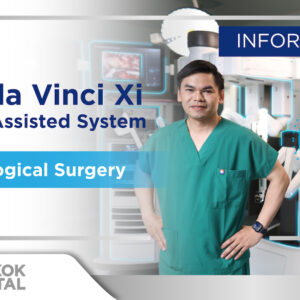
The da Vinci Xi Robot-Assisted System for Urological Surgery
The Da Vinci Xi - Robot-Assisted System for Minimally Invasive Urological Surgery
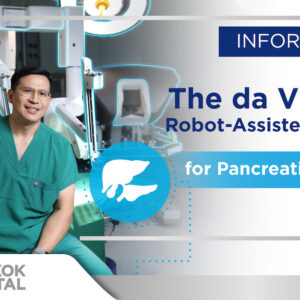
The da Vinci Xi Robot-Assisted System for Pancreatic Surgery
The Da Vinci Xi - Robot-Assisted System for Minimally Invasive Pancreatic Surgery.
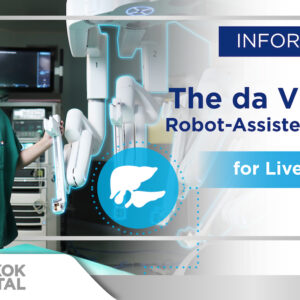
The da Vinci Xi Robot-Assisted System for Liver Surgery
The Da Vinci Xi - Robot-Assisted System For Minimally Invasive Liver Surgery.

The da Vinci Xi Robot-Assisted System for Hernia Surgery
The Da Vinci Xi - Robot-Assisted System For Minimally Invasive Hernia Surgery.
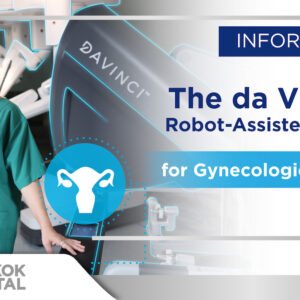
The da Vinci Xi Robot-Assisted System for Gynecologic Surgery
The Da Vinci Xi - Robot-Assisted System for Minimally Invasive Gynecologic Surgery.
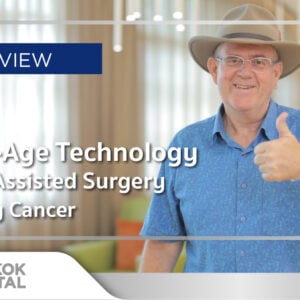
Space-Age Technology Robot-Assisted Surgery for Lung Cancer
My faith of cancer treatment in Bangkok Hospital where space-age technology is combined with hospital network excellence.
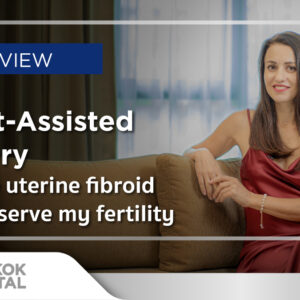
Robot-Assisted surgery - Remove uterine fibroid and preserve my fertility
I can rest worry-free if I want to get pregnant in the future. When my uterine fibroid was removed and my fertility can be preserve
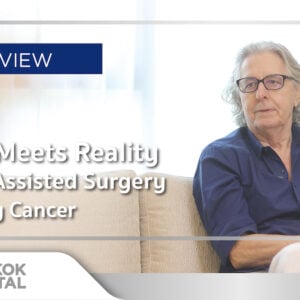
Sci-Fi meets reality. Robot-Assisted Surgery for Lung cancer
When Sci-fi meets reality and robot involves my surgery. Explore patient experience after undergoing robot-assisted surgery using the da Vinci Xi for lung cancer treatment.

Resume worry-free life. Robot-Assisted Surgery for Prostate cancer
Terminate urination problems and resume my worry-free life. Explore patient experience after undergoing robot-assisted surgery using the da Vinci Xi for prostate cancer.

Early detection saves life. Robot-Assisted Surgery for Lung cancer
When lung cancer is accidentally found during annual health check-up and early detection saves life. Explore patient experience after undergoing robot-assisted surgery using the da Vinci Xi for lung cancer treatment.
